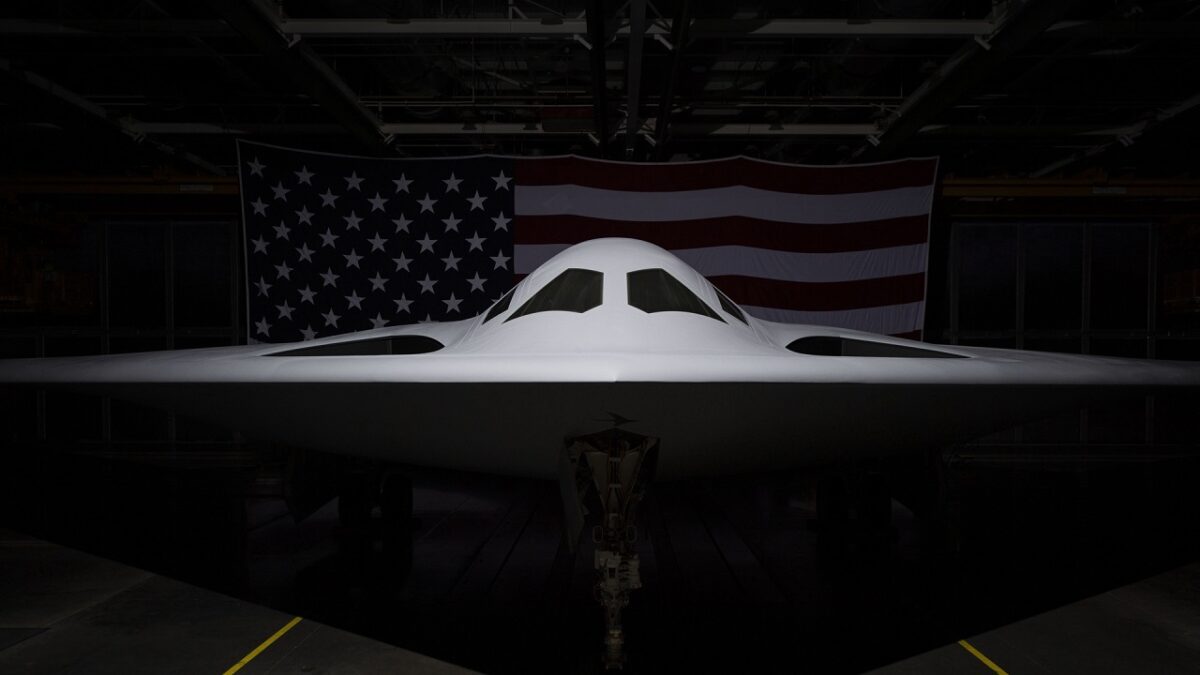The maiden flight of the United States Air Force’s Northrop Grumman B-21 Raider has been pushed back a few months; it was announced last week. The next-generation bomber was officially unveiled last December and is still on track to enter service by the end of this decade.
(Subscribe to 19FortyFive‘s New YouTube Channel here.)
However, the schedule has “slipped,” Air Force Secretary Frank Kendall explained while speaking at the McAleese & Associates conference in Washington, D.C., on Wednesday.
“It’s slipped from the original schedule — that we were using as a schedule to manage by — by a few months,” Kendall told attendees of the event.
The secretary has recused himself from any decision-making on the program, as he had previously conducted consulting work with the defense contractor. However, Kendall noted, “It’s still within the baseline that we originally had for the program.”
The aerospace firm also announced it still expects the B-21 Raider to make its first flight later this year.
“The program remains on track to the government baseline for cost, schedule and performance,” Northrop Grumman said via a statement to Defense News. “The program continues to focus on system maturity, production readiness and sustainment preparedness to best position the B-21 for first flight and an effective flight test campaign, leading to initial operating capability.”
It should also be noted that the first flight of the Northrop B-2 Spirit bomber – the last long-range strategic bomber developed for the United States Air Force – had taken place in July 1989, about eight months after its November 1988 rollout.
The B-21 was first unveiled to the public in Palmdale, California on December 2, so if history is a lesson, that maiden flight could take place in September or October.
B-21: Larger Bomber Fleet?
Even as the bomber might not take to the sky for a few more months, some military analysts are suggesting that the U.S. Air Force should go all in with the bomber and double its planned purchase of a minimum of 100 B-21 Raiders.
Colonel Mark Gunzinger, United States Air Force (Retired), who leads future concepts and capability assessments at the Mitchell Institute for Aerospace Studies, part of the Air & Space Forces Association industry group, called for the service to purchase upwards of 225 Raiders, which could operate along with the current fleet of B-1 Lancer, B-2 Spirit, and B-52 Stratofortress bombers now in service.
“More resources can buy back future risk and that’s what a more aggressive acquisition rate for the B-21 can do,” Gunzinger told reporters last week ahead of the rollout of his Mitchell Institute report, “Understanding the B-21 Raider: America’s Deterrence Bomber.”
“The continuing challenge will be to ensure the B-21 program is resourced to rapidly acquire an inventory that meets operational demands. This will require avoiding the same kind of budget driven decisions that eroded nearly all the service’s advanced combat aircraft purchases since the Cold War, as in the case of the B-2, the F-22, and now the F-35A,” the report stated.
The report further assessed the need to “rebuild a U.S. bomber force that has the capacity to simultaneously defeat Chinese aggression in the Indo-Pacific, credibly deter an opportunistic aggressor in another theater, and deter nuclear attacks on the United States—all requirements of the 2022 National Defense Strategy (NDS). Therefore, the U.S. Air Force should develop a total force of more than 300 bombers that includes at least 225 stealthy B-21s.”
Experts have also warned against any efforts to scale back the program. As Defense One reported, the United States Air Force had intended to buy more than 100 B-2s, but only ended up buying 21 of the $2 billion-a-copy stealth bombers. It would be a mistake for history to repeat itself in this case – especially as the B-21 is now part of the service’s current effort to replace most of its nuclear delivery weapons, including its ICBMs.

B-21 Raider

Gunzinger’s report also warned the Air Force currently lacks enough aircraft with the range, payload, and stealth to fight China. He further asserted that declining to double B-21 production could end up costing more than the planes’ purchase price.
“Throttling B-21 acquisition during this critical period will increase the risk of a conflict with an opportunistic China that would result in costs that exceed any temporary program savings.”
Author Experience and Expertise:
A Senior Editor for 19FortyFive, Peter Suciu is a Michigan-based writer. He has contributed to more than four dozen magazines, newspapers, and websites with over 3,200 published pieces over a twenty-year career in journalism. He regularly writes about military hardware, firearms history, cybersecurity, politics, and international affairs. Peter is also a Contributing Writer for Forbes and Clearance Jobs. You can follow him on Twitter: @PeterSuciu.

